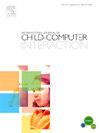A rapid and inclusive instrument for assessing children’s basic understanding of physical computing
Q1 Social Sciences
International Journal of Child-Computer Interaction
Pub Date : 2024-12-09
DOI:10.1016/j.ijcci.2024.100709
引用次数: 0
Abstract
While there are many initiatives that strive to empower children with physical computing, there seems to be no validated questionnaire for rapidly measuring different children’s understanding of the basics of physical computing. This paper presents the design of such an instrument—PCBUQ. It is rapid in that it consists of few items. It is inclusive because designed for different young children. It is for the basics of physical computing in that it considers physical input and output devices, basic patterns and programs that use them for interacting with the physical world. Data gathered from experts, primary and middle schools were used to validate PCBUQ. The first items assess children’s capability of classifying physical devices as input (e.g., buttons), and output devices (e.g., LED, speaker). The other items evaluate whether children can interpret problematic scenarios and infer how to resolve them with adequate input and output devices, patterns and programs. PCBUQ was found to have adequate reliability. The reported statistical analyses highlight the items that strongly and weakly correlate with the construct under analysis, their difficulty and discrimination. Results are discussed to guide future physical computing initiatives for children and their assessment.
一个快速和包容的工具,用于评估儿童对物理计算的基本理解
虽然有许多倡议努力赋予儿童物理计算能力,但似乎没有有效的问卷来快速衡量不同儿童对物理计算基础知识的理解。本文介绍了这样一种仪器——pcbuq的设计。它是快速的,因为它由很少的项目组成。它是包容性的,因为它是为不同的孩子设计的。它是物理计算的基础,因为它考虑了物理输入和输出设备、基本模式和使用它们与物理世界交互的程序。从专家、小学和中学收集数据来验证PCBUQ。第一个项目评估儿童将物理设备分类为输入设备(如按钮)和输出设备(如LED,扬声器)的能力。其他项目评估儿童是否能够解释有问题的场景,并推断如何通过适当的输入和输出设备、模式和程序来解决问题。发现PCBUQ具有足够的可靠性。报告的统计分析突出了与被分析结构强相关和弱相关的项目,它们的难度和区别。讨论的结果,以指导未来的物理计算倡议的儿童和他们的评估。
本文章由计算机程序翻译,如有差异,请以英文原文为准。
求助全文
约1分钟内获得全文
求助全文
来源期刊

International Journal of Child-Computer Interaction
Social Sciences-Education
CiteScore
7.20
自引率
0.00%
发文量
73
 求助内容:
求助内容: 应助结果提醒方式:
应助结果提醒方式:


